List of Contents
Vehicle-to-Grid Technology Market Size and Forecast 2025 to 2034
The global vehicle-to-grid technology market size was estimated at USD 5.54 billion in 2024 and is anticipated to reach around USD 49.75 billion by 2034, expanding at a CAGR of 28.13% between 2025 and 2034. The global vehicle-to-grid technology market is expected to be driven by the emergence of electric vehicles across the globe.
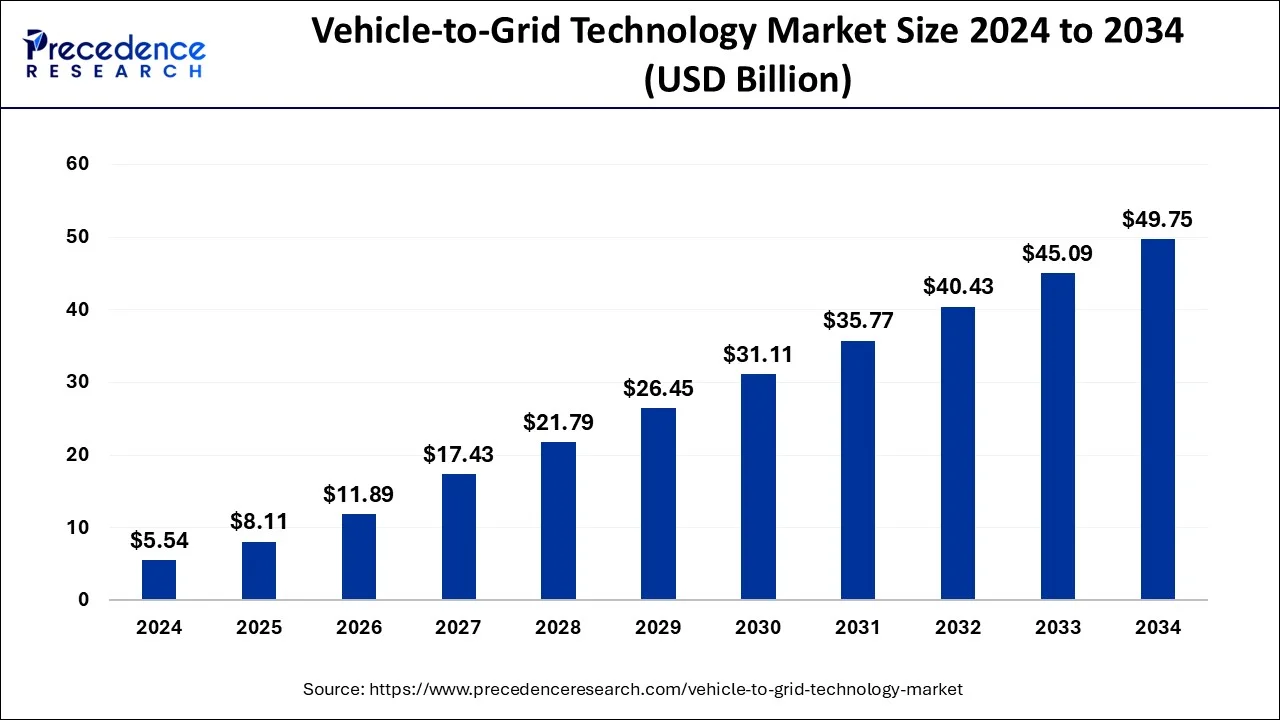
Vehicle-to-Grid Technology Market Key Takeaways
- Europe has led the global market with the highest market share of around 35.80% in 2024.
- By Component Type, the electric vehicle supply equipment segment has held the maximum revenue share of 83.13% in 2024.
- By Application, the battery electric vehicles (BEVs) segment held the major market share 63.89% in 2024.
- By Application, the plug-in hybrid electric vehicles (PHEVs) segment is anticipated to grow at a remarkable CAGR of 28.59%.
How has AI benefited the vehicle-to-grid technology market?
Artificial intelligence makes vehicle-to-grid systems more intelligent and efficient. AI requires data from electric vehicles, their batteries, the electrical grid, and in some cases, is used to predict weather information. AI will analyze this data and provide the best opportunity for electric vehicles to charge or export power back to the grid. Electric vehicle owners can capitalize on additional revenue streams, and grid operators can safely moderate overall electricity demand. Some AI solutions have included the development of reinforcement-learning algorithms, which employ a previous history of energy use from which to begin predicting demand up and down, and will automatically make charge changes. Other AI solutions incorporate digital twins of vehicles, virtual representations, during the performance of real drive data to reach online information so that, in many cases, their decisions based on the unavailable data set are accurate. AI can monitor battery health and deter unwanted operational failures, and predict when maintenance occurs, planned maintenance, which could extend battery life. Companies and researchers are testing AI-based controllers that many EVs can coordinate to form a fleet that, in fact, is a virtual power plant. AI enables V2G systems to operate efficiently, effectively, and intelligently.
- Researchers employed a digital twin methodology together with AI to predict the state of charge for electric vehicles, including the Citroën Ami and Nissan Leaf. The AI model that the researchers developed had identified a prediction error of only 1.28% to optimize real-time V2G energy exchange.
Europe Vehicle-to-Grid Technology Market Size and Growth 2025 to 2034
The Europe vehicle-to-grid technology market size accounted for USD 1.98 billion in 2024 and it is expected to be worth around USD 17.66 billion by 2034, recording a CAGR of 28.05% over forecast period 2025 to 2034.
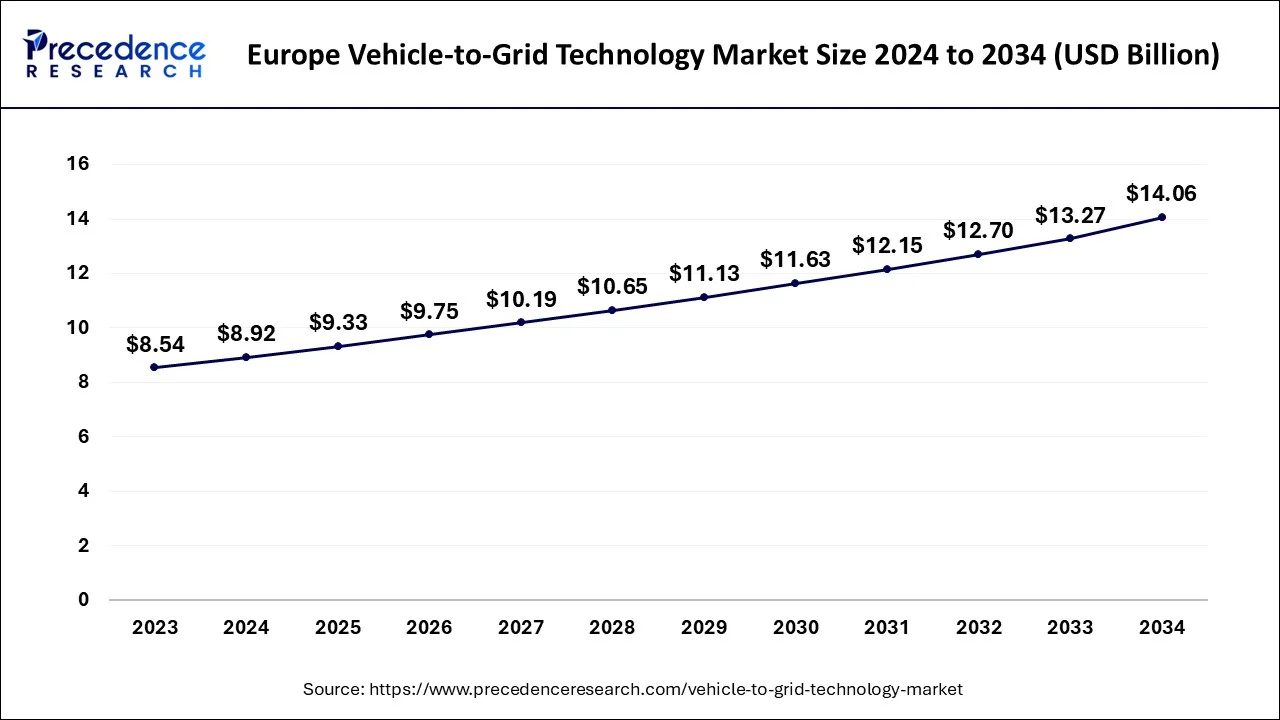
North America and Europe are the key regions in the global vehicle-to-grid technology market with significant revenue contribution in 2023. Government initiatives promoting the use of battery-powered vehicles to control carbon emission rate are the major factors that propels the market growth. In addition, long-term warranty offered by the manufacturers along with subsidies and benefits offered by the government on the adoption of electric vehicles attract large consumer base.
North America experiences the fastest growth in the market during the forecast period. The increasing number of electric vehicles and growing adoption of V2G technology help the market growth. The supportive government policies for the adoption of EVs in countries like Canada and the U.S. increase demand for V2G technology. The growing integration of renewable energy sources and the presence of advanced grid infrastructure support the overall growth of the market.
The widespread deployment of autonomous vehicles and the increasing use of smart power generation systems are the primary drivers driving market expansion. In comparison to conventional internal combustion autos, hybrid and electric vehicles are more fuel efficient and consume less fuel. Another growth-inducing component is substantial innovation in the manufacturing processes of vehicle batteries.
Auto manufacturers in these regions are also taking initiative to promote vehicle-to-grid technology as it improves their value chain by improving the battery life. For instance, in December 2018, Nuvve Corporation signed a partnership agreement with EDF Group to implement vehicle-to-grid technology in the European market.
Germany Vehicle-to-Grid Technology Market Trends
Germany is a major contributor to the vehicle-to-grid technology market. The strong government support through various investments, subsidies, and tax breaks for the adoption of electric vehicles increases demand for vehicle-to-grid technology. The strong focus on digitalization in various sectors like manufacturing, automotive, and energy increases demand for V2G technologies. The strong presence of advanced infrastructure increases demand for V2G technology. The growing sales of electric vehicles and fleet operations fuel the adoption of V2G technology. The presence of key companies like BMW and Volkswagen drives the overall growth of the market.
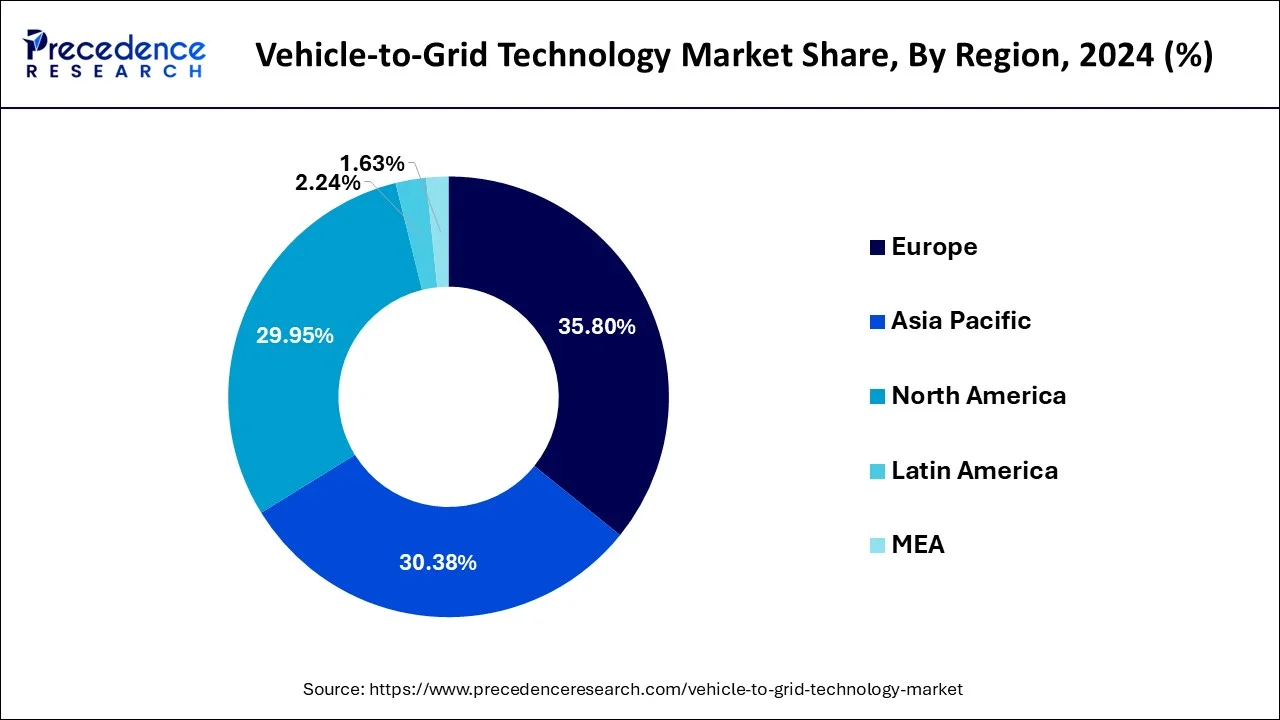
On the contrary, Asia Pacific projected lucrative growth for vehicle-to-grid technology during the forecast period. The prime factors contributing to the significant growth are green revolution drives in Asian countries such as China, Japan, India, and South Korea. For instance, China has vision of fully electric-powered mobility in the region by 2025 and is investing significantly for the same.
Automobile batteries that have been developed recently have a longer operational life and can withstand repeated charging cycles without deterioration. Furthermore, the introduction of vehicle-to-everything technology as an extension of vehicle-to-grid with a smaller size, lighter weight, and easier installation process is fueling market expansion. The market is expected to be driven by massive infrastructural developments and the implementation of favorable government policies boosting smart grid initiatives.
Market Overview
Vehicle to grid is a system that allows various types of electric cars such asbattery electric vehicles,fuel cellvehicles, plug-in hybrid electric vehicles, and others to interface with the power grid in order to provide demand response services by delivering two-way electricity exchange. One of the primary factors driving the growth of the vehicle to grid market is the increasing use of electric vehicles around the world, which is affecting demand forelectric vehicle charging infrastructuressuch as unidirectional and bidirectional power flow charging. Furthermore, the government's expanding measures to promote the use of environmentally friendly electric vehicles, as well as growing public awareness of environmental issues, has accelerated the expansion of the vehicle to grid industry.
Rising adoption of electric vehicles across the globe has greatly transformed the energy sector. Battery-powered cars proved to be largely effective in controlling carbon emission. Developed regions such as North America and Europe have significantly adopted the electric vehicle technology, along with this; the developing countries have shown tremendous interest for adoption of electric vehicles as a mode of future transportation. Prime factor responsible for the rising demand for electric vehicles is green revolution drives in several nations to protect environment from increasing pollution.
Furthermore, some of the regions such as North America have amended their regulations to support the vehicle-to-grid technology. For instance, National Electric Code (NEC) was amended in 2011 that describes the equipment construction, wiring methods, equipment locations, and control & protection of Electric Vehicle Supply Equipment (EVSE). Additionally, International Codes (I-Codes) that is applicable for vehicle-to-grid technology include International Residential Code (IRC), International Energy Conservation Code (IECC), and International Building Code (IBC). Each code is revised in three years with the required amendments made. The aforementioned factors significantly drive the vehicle-to-grid technology market.
Market Scope
| Report Coverage | Details |
| Growth Rate from 2024 to 2034 | CAGR of 28.13% |
| Market Size in 2025 | USD 8.11 Billion |
| Market Size by 2034 | USD 45.09 Billion |
| Largest Market | North America |
| Base Year | 2024 |
| Forecast Period | 2025 to 2034 |
| Segments Covered | Component Type, Application Type, and Region |
| Regions Covered | North America, Europe, Asia-Pacific, Latin America, and Middle East & Africa |
Market Dynamics
Drivers
Escalating adoption of electric vehicles across the globe has greatly transformed the energy sector
Intensifying awareness for smart power generation along with increasing adoption of autonomous vehicles has suggestively triggered the demand for vehicle-to-grid technology. Further, the government of numerous regions offering incentives and other paybacks over the petrol- and dieselpowered vehicles to boost the adoption of battery powered vehicles fuels the market growth prominently. Thus, global EV-sales volumes are becoming large enough to generate significant profit pools for well-established suppliers and other upstream participants. Influences such as upsurge in demand for fuel-efficient, and low-emission vehicles, high-performance, along with rigorous government rules and regulations toward vehicle emission complements the growth of the electric vehicle market. This in turn motivates the vehicle to grid technology market players.
Surge in demand for electric vehicles
The adoption of latest and new technologies is driving the demand for electric vehicles such as battery electric vehicles and plug-in electric vehicles in the global market. As a result, surge in demand for electric vehicles are driving the growth of global vehicle-to-grid technology market.
Restraints
High Initial cost
High initial cost of the technology over specific period of time hampers the market growth. Repairing companies, automobile owners, and oil industries show resistance to the high cost of existing technology. Further, lack of Infrastructure and lack of knowledge about the technology, driver's anxiety of vehicle range, and data security are some of the issues that will curb to the growth of the market. A bidirectional charger or an electric vehicle supply equipment is essential to charge an electric vehicle battery and supply electricity back to the grid. Developments in the batteries of electric vehicles have been very slow as than other technologies. Dearth of infrastructure and high initial costs of electric vehicles with vehicle-to-grid technology make it tough for these vehicles to strive with conventional vehicles with internal combustion engines. Nonetheless, the augmented battery life and change of preference in the customer's choice anticipated to accelerate the market in the coming years.
Despite the fact that the vehicle to grid business is quickly expanding, high beginning costs and a lack of investment are two of the market's primary challenges. When compared to large power plant power generation, vehicle-to-grid is not a cheap source and requires large investments, which is a key problem for the market's growth. Furthermore, the initial cost of establishing a new electric vehicle charging station is quite high, limiting the market's expansion. As a result, these issues are expected to stymie the growth of the vehicle-to-grid market over the forecast period.
Stringent government regulations
Several countries have stringent regulations governing how electricity from individual producers can be pumped into the system. In addition, a number of administrative procedures necessitate government permission. Owners of battery electric vehicles and plug-in hybrid vehicles do not appreciate such convoluted procedures. As a result, market participants are overcoming stringent rules by building standardized vehicle-to-grid protocols that strike the correct balance between grid network security and the smooth application of this technology.
Opportunities
Grid stability and peak load support
One key area of opportunity in the next few years relies on V2G to combat grid instabilities and effectively relieve peak load stress. Several governments in the Asia Pacific region are struggling with the rising demand for electricity as urban areas grow. V2G can allow fleets of electric vehicles to send stored energy back into the grid when demand peaks, as a strategy to prevent issues such as outages, to support the integration of renewable sources of energy, such as solar and wind, and to help the utility industry avoid unnecessary capital expenditures on power plants. Pilot programs have already been conducted in nine cities in China, purporting to demonstrate real viability for growth.
Component Insights
Electric Vehicle Supply Equipment (EVSE) expected to outpace the global vehicle-to-grid technology market by the year 2034. In 2023, Electric Vehicle Supply Equipment (EVSE) contributed significant revenue share around 82% owing to their increasing usage for connecting electric vehicle to the grid. The EVSE are the main component that connects EV to the electric grid and thus increasing trend for renewable and smart energy generation will flourish the demand for EVSE components. The EVSE is helpful in charging the electric vehicles and supplying energy back to the grid. This factor drives the EVSE segment significantly in the coming years. 95% of the times, the electric vehicles are not in use, the vehicle-to-grid technology helps to use that energy by supplying energy back to the grid. This helps in achieving the electricity requirement during peak hours. In addition, they also fulfill the requirement during blackouts and natural calamities to run the necessary or emergency services.
The electric vehicle supply equipment is the essential component that connects an electric vehicle to the electric grid, hence the need for electric vehicle supply equipment components will grow as the trend for renewable and smart energy generation grows. The electric vehicle supply equipment is useful for charging electric vehicles as well as supplying electricity to the grid. This element will have a big impact on the electric vehicle supply equipment market in the next years.
Global Vehicle-To-Grid Technology Market Revenue, By Component, 2021-2023 (USD Million)
| Component | 2021 | 2022 | 2023 |
| Smart Meters | 114.5 | 165.8 | 240.10 |
| Electric Vehicle Supply Equipment (EVSE) | 1,467.00 | 2,150.30 | 3,154.10 |
| Software | 103.7 | 149.1 | 214.3 |
| Home Energy Management (HEM) | 88.6 | 126.7 | 181 |
Application Insights
Battery Electric Vehicles (BEVs) held significant revenue share in the global vehicle-to-grid technology market in 2024. The prime factor behind the significant growth of the segment is 100% powered by energy storage system in the vehicle. This helps the vehicle to return back maximum power to the grid. Further, in 2018, Nissan Motors Co. Ltd. announced its first electric car Nissan Leaf that secured regulatory approval for power backup for Germany's electric grid. With the pilot project in January 2019, the company sold 8 kWh of electricity back to the grid. The fact that the category is 100% powered by an energy storage system in the vehicle is the main reason for its rapid expansion. This aids the vehicle in returning the maximum amount of power to the grid.
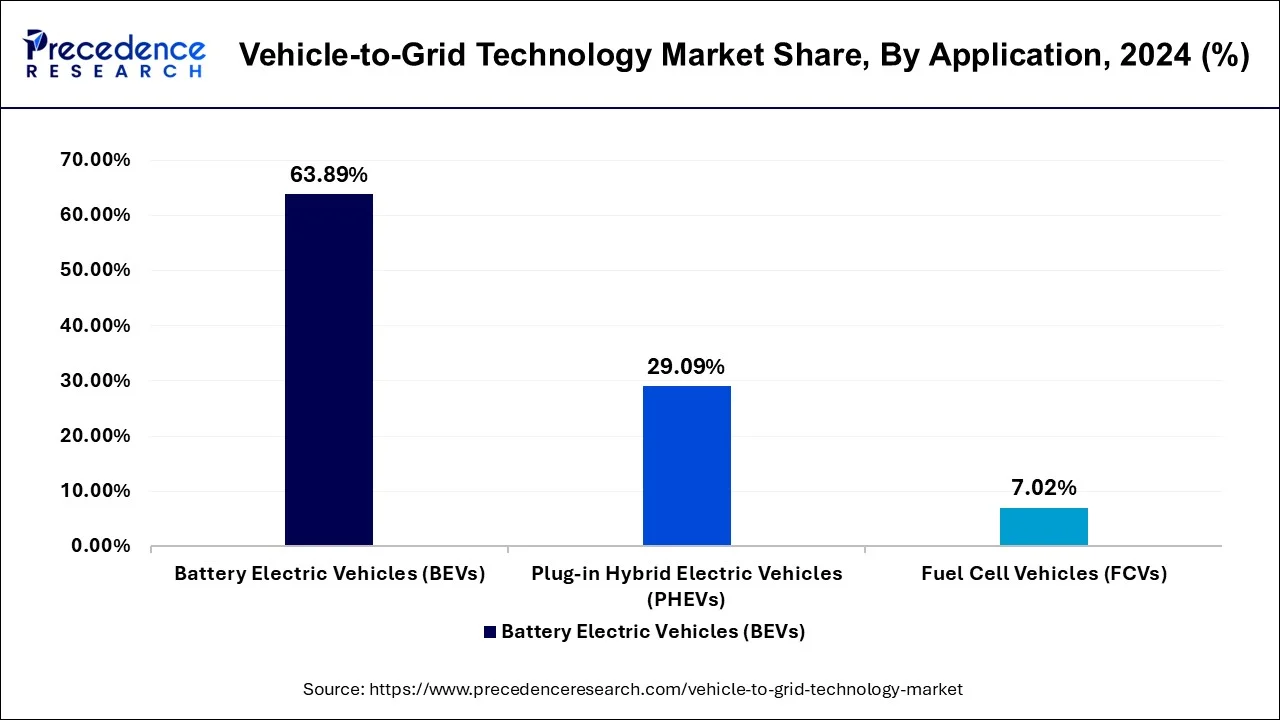
On the other hand, Plug-in Hybrid Electric Vehicles (PHEVs) exhibits the fastest growth over the forecast period. PHEV consist of larger battery and plug-in charger that can power it to run up to 20 to 60 miles after charging for only one hour. Larger battery size has higher capability to revert the large amount of power back to the grid. Thus, PHEVs expected to return back more power grid and the owners can earn more through this. In addition, the rising popularity of PHEVs being more driver-friendly along with their lucrative benefits over the BEVs has significant potential to drive the market in the years to come.
Key Companies & Market Share Insights
The global vehicle-to-grid technology market is highly competitive with prominent on-going developments in the market. The market players are largely focused towards technology investment, partnership and merger & acquisition strategy for cementing their footprint in the market.
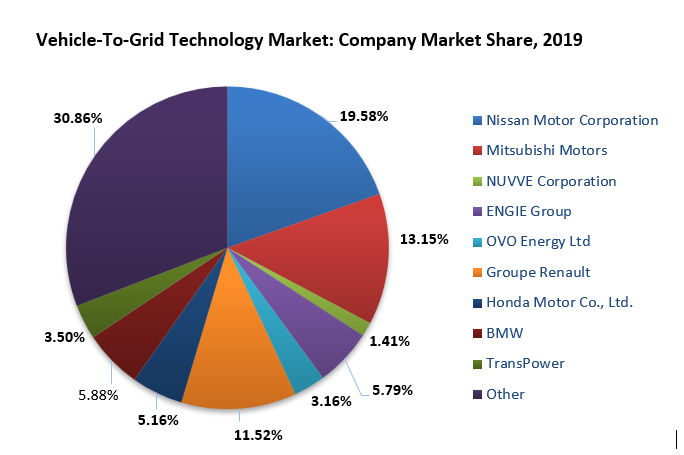
In June 2018, Hitachi and Mitsubishi collaborated together to establish vehicle-to-grid charging network for PHEVs and BEVs at several places in Japan. Similarly, in June 2019, ENGIE entered into an agreement with Fiat Chrysler Automobiles (FCA) to offer new electric-powered mobility solutions in fourteen different countries of Europe. The company planned to offer FCAs with its charging station for its customers and dealers in Europe. Thus, significant initiative from auto-manufacturers to promote the vehicle-to-grid technology has prominent impact on the market growth.
Nuvve Corporation and EDF Group formed a strategic cooperation in December 2018 to promote the latter's electric mobility goal. The two companies are anticipated to create electric vehicles and vehicle-to-grid solutions for the European market as a result of their relationship.
OVO Energy Ltd declared a strategic investment from Mitsubishi Corporation in February 2019 in exchange for a 20% share in the company. This funding will be used to expand into new markets in Europe and Asia Pacific, as well as to accelerate the development of Kaluza, the company's unit for intelligent energy solutions.
Vehicle-to-Grid Technology Market Companies
- Nissan Motor Corporation
- Mitsubishi Motors Corporation
- NUVVE Corporation
- ENGIE Group
- OVO Energy Ltd
- Groupe Renault
- Honda Motor Co., Ltd.
Recent Developments
- In July 2025, Kerala State Electricity Board partnered with IIT Bombay to launch the country's first vehicle-to-grid project. The project continues in two phases: a detailed feasibility study and development of the V2G system. The project supports rooftop solar integration, peak load management, and frequency regulation. (Source: https://thesouthfirst.com)
- In June 2025, Octopus Energy and BYD launched the UK's first V2G bundle. The new product consists of a bidirectional Zaptec Pro charger and a leased BYD Dolphin. The product offers access to the Octopus smart energy tariff and free home charging. The product provides benefits like stabilization of the power grid, predictable monthly cost, and free & discounted charging. (Source:https://www.electrive.com)
- In October 2024, Nissan is to launch an affordable vehicle-to-grid technology in 2026. The bidirectional vehicle-to-grid technology minimizes electricity bills and offers net-zero carbon emissions. (Source: https://global.nissannews.com)
- In July 2025, Ausgrid launched V2G for electric vehicles. The V2G reduces the need for infrastructure upgradation, offers simple transport tools, and supports the electricity grid during high-demand periods. (Source: https://fleetevnews.com.au)
- In November 2024, Utrecht hosted vehicle-to-grid car sharing services in Europe with Renault Group & We Drive Solar. The service helps customers stabilize grids during demand and lower electricity costs. The Renault company offers 500 electric cars, and We Drive Solar offers bidirectional public AC charging. (Source: https://www.pv-magazine.com)
- In October 2024, according to the Fraunhofer studies' analysis, V2G could deliver approximately €9.7 billion in annual energy-system savings by 2030, about 5.5 % savings, and over €100 billion in total cumulative savings between 2030-2040. ( Source: https://evboosters.com )
- In June 2025, Octopus Energy and BYD launched the first V2G "Power Pack Bundle" in the UK at their Energy Tech Summit. Priced at under £300 a month, the Power Pack Bundle brings together a leased BYD Dolphin that has V2G charging technology, a Zaptec Pro electric vehicle (EV) charger, and a smart tariff that provides free charging at home, offering typical drivers an average annual savings of around £620.
( Source:https://www.evinfrastructurenews.com )
- In June 2025, Amber Electric raised AU$45 million to grow its vehicle-to-grid (V2G) technology and expand in the UK and Europe. The funding round was led by ETF Partners, supported by Square Peg and some other investors. Through the funding, Amber was looking to scale its smart EV and battery platform and build further partnerships with UK energy companies, including E.ON and Ecotricity. ( Source : https://www.current-news.co.uk )
Segments Covered in the Report
This report analyses and projects market revenue and growth trend at global, regional, and country levels and offers an analysis of the modern industry developments in each of the sub-segments from 2025 to 2034. This research report bifurcate global vehicle-to-grid technology market on the basis of component, application, and region:
By Component Type
- Smart Meters
- Electric Vehicle Supply Equipment (EVSE)
- Software
- Home Energy Management (HEM)
By Application Type
- Battery Electric Vehicles (BEVs)
- Fuel Cell Vehicles (FCVs)
- Plug-in Hybrid Electric Vehicles (PHEVs)
By Region
- North America
- Latin America
- Europe
- Asia-pacific
- Middle and East Africa
For inquiries regarding discounts, bulk purchases, or customization requests, please contact us at sales@precedenceresearch.com
Frequently Asked Questions
Ask For Sample
No cookie-cutter, only authentic analysis – take the 1st step to become a Precedence Research client